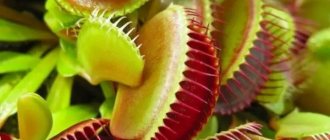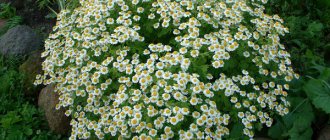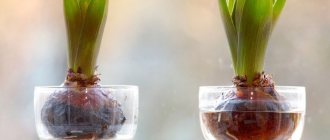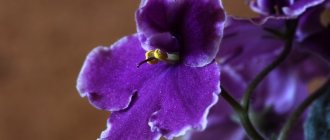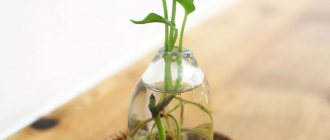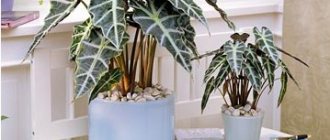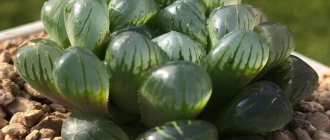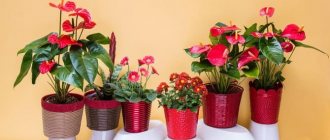Insectivores are a fairly large “collection” of plants from all over the world, there are more than 600 species! Of course, many of them are residents of distant tropics and require conditions for their cultivation that cannot be reproduced in an average apartment.
But some of the carnivorous plants come from regions with a temperate climate and, if desired, these exotics can be placed on your windowsill or even in the garden. Let's look at the most suitable options for beginning gardeners.
First, a little general information - how and why, in the process of evolution, did plants even “get it” to feed on living organisms?
Predatory plants
All these types of plants have one thing in common - they have all adapted to catching and digesting small animals. Of course, these specimens mainly “feed” on insects, but some particularly large species, such as the giant byblis from Australia, can, on occasion, “snack” on a lizard, bird or frog.
Why did plants develop this habit? In this way, they supplement their normal autotrophic nutrition (photosynthesis) with one of the forms of heterotrophic nutrition - as a result, predator plants are less dependent on soil inorganic nitrogen necessary for the synthesis of their own proteins, as well as phosphorus, potassium, sodium, magnesium and other nutrients. Additional nutrition with such animal food accelerates the development of plants and promotes their transition to flowering and fruiting.
Predatory plants catch insects with the help of trapping organs - modified leaves. They attract prey by color, smell or sweet secretions. In some leaves, the leaves transform into peculiar traps of various shapes, in others they acquire the ability to actively move, catching and holding insects.
On the surface of such leaves there are glands that secrete digestive enzymes: pepsin and organic acids, which digest the caught prey, breaking down animal proteins. The products formed as a result of such extracellular digestion, mainly amino acids, are absorbed and assimilated.
The first researchers who noticed the unusual feature of such plants did not dare to describe them in serious scientific publications for a long time, and even if they published their works on this topic, they were subjected to harsh criticism from the rest of the scientific world. The turning point in the study of unusual organisms was Darwin's extensive work, which to this day remains one of the most fundamental on this topic.
Insectivores are predominantly perennial herbaceous plants found in all parts of the world. There are 18 species growing in the CIS, belonging to two families: Sundews and Bladderworts. Although different types of carnivorous plants have different requirements for light, air humidity and soil, they share some common features that allow them to be grown at home.
They need watering with special demineralized water with a slightly acidic, almost neutral environment - ordinary tap water contains mineral salts that quickly accumulate in tissues and can destroy such a plant.
Most carnivorous plants require bright light and high humidity. Different species react differently to the ambient temperature, so this parameter needs to be clarified further if you decide to have such a plant at home.
Mature healthy plants are able to provide themselves with the necessary amount of insects - you can only occasionally carefully offer them a small insect to supplement the diet.
The second most common cause of death of domestic insectivorous plants, after watering with plain water, is mechanical impact on traps in order to examine them closely and regular force feeding of them with various inappropriate products.
Which predator plants can be grown at home without much effort and time?
Carnivorous plants at home
Predatory plants are designed to perform the functions of orderlies and clear the space from too many different insects. These plants have a special mechanism that helps them attract and capture their prey.
Carnivorous flower on which a wasp landed
In addition to useful functions, predatory flowers can decorate any interior, as they look very beautiful.
The main advantages of growing carnivorous plants include the fact that they do not require any special care; on the contrary, these flowers are quite unpretentious and are quite easy to keep indoors. Also, these strange representatives of the flora will be able to please their owner with delightful flowers, which is also important when choosing a houseplant.
Predatory flowers differ from ordinary houseplants in that they are able to catch and digest insects. This ability in carnivorous flowers appeared as a result of evolution, when they grew in poor soil and could not obtain the necessary minerals from the ground through the roots. It was for this reason that the flowers were forced to mutate and began to receive nutrition not from the ground, but through the air.
Insectivorous flower with pitchers
Carnivorous house plants should not be fed with mineral fertilizers; they should only be watered with distilled water. What is very important is that such flowers are absolutely safe for people, since they are carnivorous plants and not poisonous.
Sundew
Sundew is a low herbaceous perennial, some species of which grow across all continents in highly moist biotopes, while others grow high in the mountains.
Sundews are classified as “active predators.” Its leaves, usually collected in a basal rosette, are lined with large glandular hairs that become irritated on contact and secrete mucus that serves to trap insects. After the prey falls into the trap, the leaf gradually curls and digestion of the insect begins with the help of special alkaloid substances. Once the insect is digested (usually taking several days), the leaf opens again.
The speed of leaf folding is different for different sundew species, and the mechanism is selective - the leaf reacts only to protein foods, while accidental impacts in the form of a drop of water or a fallen leaf do not trigger the start of the digestive process.
Many types of sundews are grown as ornamental houseplants. Due to their size and comparative unpretentiousness (they come from cool-temperate climates), these are primarily cape and disyllabic sundews. The latter differs from most sundew species in having unusual, very narrow forked leaves.
At home, sundews are suitable for regular watering and spraying (especially in winter), diffuse lighting and air temperature within 16-25°C.
What should the soil and pot be like for indoor predators?
The first place to start is with recommendations for planting carnivorous plants. When choosing a pot, it is better to give preference to plastic containers , avoiding ceramic ones, which over time release substances dangerous to phytopredators into the soil. It is also important to have a drainage hole in it, which removes excess moisture from the soil and prevents excess dampness in it.
A drainage layer in the form of sea pebbles or screenings, previously calcined in the oven, will help to increase the efficiency of moisture removal.
The soil for phytopredators must be special. It should contain peat, perlite and sphagnum moss. It is acceptable to add crushed coal, coconut substrate and soil for orchids.
Under no circumstances should carnivorous plants be planted in fertile black soil and garden soil.
Separately, it is worth noting the frequency of transplanting exotic plants. Their roots grow rather slowly, so the size of the pots needs to be increased approximately every 2-3 years.
Venus flytrap
The Venus flytrap is a plant native to the swampy areas of North America. Apparently this initial growth on soils poor in nitrogen “stimulated” the development of the plant’s unusual ability to obtain additional food for itself.
The Venus flytrap catches its victims (insects, arachnids) using a specialized bivalve trapping apparatus formed from the edges of leaves. The slamming of the trap is initiated by fine sensitive hairs on the surface of the leaves. Moreover, the collapse occurs very actively - this species belongs to an extremely small group of plants capable of rapid movements.
The mechanism is also selective - collapse requires mechanical action on at least two hairs and a certain amount of time, and digestion of the contents begins no earlier than fivefold stimulation of the hairs.
To thrive in an apartment, the flycatcher needs diffused light, regular watering with spraying and a temperature within 10-22°C. Most often, the Venus flytrap suffers in winter when the air is dry and too hot, when even regular spraying and ventilation do not help - it is often infected with gray mold.
Sarracenia
Sarracenia is another marsh plant, and some species can grow directly in the water. Unlike the two genera of insectivores described above, this is a “passive predator.”
Sarracenia has specialized, open only at the top, tall leaves-tubes (trap-pitchers) with a small “canopy”. The edges of the pitcher-shaped leaf secrete a sweet juice that attracts insects. At the bottom of such a trap there is digestive juice from a mixture of acids, and sometimes also a colony of bacteria with mosquito larvae that help the plant digest its prey.
At home, sarracenia can grow in a mixture of high-moor sphagnum peat or coconut shavings with sand (3:1), which must be kept constantly moist. It thrives in bright light, frequent misting and temperatures around 22°C.
Most often in cultivation you can find unpretentious yellow sarracenia with hollow leaves with an internal pattern and yellow flowers, as well as purple sarracenia and various hybrids.
Lighting and humidity requirements
Ornamental carnivorous plants are mainly native to the tropics. Therefore, sun and moisture are the primary requirements for keeping them at home. Pots with phytopredators should be placed where there is a lot of light, but no direct sunlight. Direct exposure to the sun threatens plants with burns of leaves, which are not only a trapping organ for them, but also a digestive organ.
But the lack of light does not have the best effect on representatives of the carnivorous flora . In this case, the plants will go into hibernation earlier than expected, will not be able to bloom, or will completely lose their above-ground parts (depending on the species).
Phytopredators require high humidity only during the growing season. For most species of indoor predators, this period is from May to mid-October.
There is no need to water the soil in pots. It is enough to pour water into the pan and make sure that it does not dry out. It is important to use only rain or distilled water for this. Mineral substances contained in other types of water can cause irreparable harm to plants, including their death.
Nepenthes (pitcher)
Most representatives of this genus grow in tropical Asia, sometimes reaching tens of meters in length in a liana-like form. Of course, we are not talking about them now, but about small species of Nepenthes, which grow quite successfully in apartments in large terrariums, in relatively constant warm and humid conditions.
Like the Sarracenia described above, the hunting tool of Nepenthes is a pitcher leaf. Different plant species have pitchers of different sizes, shapes and colors. Their length varies from 2.5 to 30 cm, and in some species it can reach 50 cm. More often, the jugs are painted in bright colors. The leaf secretes sweet nectar to attract insects, and the digestion of prey occurs due to the digestive fluid at the bottom.
Some tropical species of Nepenthes, in the process of life, have adapted to digest in their pitchers not only insects, but also fallen leaves or droppings of birds and animals.
The most universal substrate composition for nepenthes is a mixture of sphagnum moss and perlite (1:1). The relative air humidity for this plant should be very high, at 70-90%, and the optimal air temperatures for different species range from 25-34°C during the day and 8-10°C at night.
Zhiryanka
This genus is the most non-exotic among insectivores - its wild representatives can easily be found in central Russia in wet meadows and swamps.
The fleshy “buttery” leaves of butterworts (which is why the name is given), small herbaceous perennials, form basal rosettes. The upper side of the leaf is covered with numerous glands - some of them secrete sugary mucus, which is a bait for small insects, while others generate enzymes that facilitate the digestion of prey. The movements of the caught insects lead to a slow curling of the leaf, and the mucus dissolves the proteins of the victim’s body. For small insects, the sticking effect is sufficient - the plant does not even need to roll up the leaves.
In cultivation, the most commonly grown plants are the unpretentious and hardy butterwort with small blue-violet flowers, the grandiflora with beautiful long-blooming purple flowers, and the moranica with pink flowers.
If your windowsills are overflowing with the usual geraniums and violets, maybe it's time to grow some truly unusual indoor plants?
Diseases and pests
Like any indoor plants, phytopredators are susceptible to some types of diseases and pests. Among them:
- A spider mite that especially prefers to settle on the leaves of pitcher plants. Insecticides will help get rid of it.
- Aphids that colonize the leaves of plants that are not traps. You can eliminate it with a soap solution.
- Scale insects are small insects that attack predators. Insecticides are also used to combat them.
- Gray rot is the most common danger for carnivorous plants. It is difficult to remove; it is much easier to prevent its appearance. To do this, it is necessary to avoid excess moisture in the soil and provide high-quality drainage to remove it.
Separately, we note fungal diseases that threaten not only phytopredators, but also all indoor plants. Treating the soil with special antifungal compounds before planting and during replanting will help prevent the appearance of fungus.
